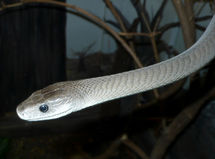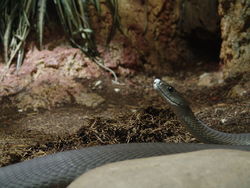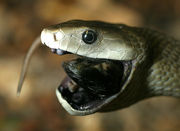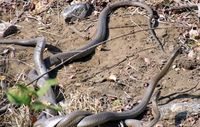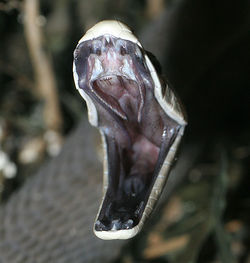Black mamba
| Black mamba | ||||||||||||||||||||
|---|---|---|---|---|---|---|---|---|---|---|---|---|---|---|---|---|---|---|---|---|
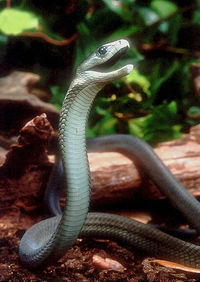 A black mamba in defense mode
| ||||||||||||||||||||
| Conservation status | ||||||||||||||||||||
| Scientific classification | ||||||||||||||||||||
| ||||||||||||||||||||
| Binomial name | ||||||||||||||||||||
| Dendroaspis polylepis Günther, 1864[2][3] | ||||||||||||||||||||
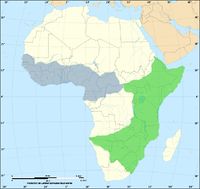 In green, range of D. polylepis
In bluish-grey, D. polylepis may or may not occur here | ||||||||||||||||||||
| Synonyms | ||||||||||||||||||||
|
The black mamba (Dendroaspis polylepis), also commonly known as the common black mamba or the black-mouthed mamba[4] is a species of large, highly venomous snake belonging to the Elapidae family and native to Africa. The black mamba is the longest venomous snake species in Africa, measuring between 2.5 and 3.2 m (8.2 and 10 ft) in length on average, and capable of growing to lengths of 4.45 m (14.6 ft).[5] This species is named for the black colouration inside the mouth rather than the colour of its scales, which varies from dull yellowish-green to a gun-metal grey. It is the fastest snake in the world, capable of moving at 4.32 to 5.4 metres per second (16–20 km/h, 10–12 mph).[6] Black mambas are fast, nervous, lethally venomous and, when threatened, highly aggressive. They have been blamed for numerous human deaths, and African myths exaggerate their capabilities to legendary proportions. For these reasons, the black mamba is widely considered to be the world’s deadliest snake.[6][7] Before the advent of black mamba antivenom, a bite from this species was 100% fatal, usually within about 20 minutes in very severe cases of envenomation.[6][8][9]
Taxonomy and etymology
The black mamba is one of four species in the African snake genus Dendroaspis that are known as mambas.[10] The species was first described in 1864 by Albert Günther, a German-born British zoologist, ichthyologist, and herpetologist.[11] Soon after, a subspecies was identified, Dendroaspis polylepis antinorii (Peters, 1873), but this is no longer accepted as distinct.[2][3][12] The genus and species name are derived from Ancient Greek words - Dendroaspis meaning "tree asp" (dendro is "tree", while aspis is "asp" which is understood to mean a "venomous snake") and polylepis, "many scaled", from poly "many" and lepis "scales".[13] The name "black mamba" is given to the snake not because of its body colour but because of the ink-black colouration of the inside of its mouth, which it displays when threatened.[6] In 1896, zoologist George Albert Boulenger combined the species (Dendroaspis polylepis) as a whole with the eastern green mamba, Dendroaspis angusticeps, and they were considered a single species from 1896[14] until 1946.[15]
Physical Description
The adult black mamba's back skin color is olive, brownish, gray, or sometimes khaki in color. A young snake is lighter in colour, appearing gray or olive green, but not light enough to be confused with the different species of green mamba. Its underbody is cream-colored, sometimes blended with green or yellow.[5] Dark spots or blotches may speckle the back half of the body, and some individuals have alternating dark and light scales near the posterior, giving the impression of lateral bars.[10] The inside of the mouth is a dark blue to inky black in colour. The head is large but narrow and elongated, with a distinct shape of a coffin. It is a proteroglyphous snake, meaning it has immovable, fixed fangs at the front of the maxilla. The eyes are dark brown to black, with a silvery-white to yellow edge on the pupils.[16] These snakes are strong but slender in body: adult specimens are 2.5 to 3 m (8.2 to 9.8 ft) in length on average,[6] but specimens measuring 3.1 to 3.75 m (10 to 12.3 ft) are relatively common, and some specimens have reached lengths of 4.4 m (14.6 ft).[5] The longest scientifically measured, wild-caught black mamba recorded was 4.48 metres (14.7 ft) long and weighed 11.7 kilograms (26 lb), found in Zimbabwe.[17] Black mambas weigh about 5.6 kilograms (12 lb) on average, though they can weigh up to 12.5 kilograms (28 lb). There is no real sexual dimorphism, and both male and female snakes of this species have a similar appearance and tend to be similar in size. The species is the second-longest venomous snake in the world, exceeded in length only by the King cobra (Ophiophagus hannah).[16] Information regarding the lifespan of snakes in the wild is sparse; the longest recorded lifespan of a captive black mamba is 14 years, but actual maximum lifespans could be much greater.[18] As black mambas age, their colouration tends to get darker.[10]
Scalation
There are 23-25 rows of smooth dorsal scales at midbody (rarely 21 rows), 248-281 ventrals and 109-132 paired subcaudals. The anal shield is divided. There are 7-10 upper labials, with the fourth (or third and fourth) entering the eye, and 11-13 lower labials (sometimes 10 or 14). There are three (sometimes four) preoculars and three or four (sometimes two or five) postoculars. Temporals are variable, usually 2+3.[5]
Distribution, habitat and status
Geographical Distribution
Although it is a large diurnal snake, the distribution of the black mamba is the subject of much confusion in research literature, indicating the poor status of African herpetological zoogeography.[19] However, the distribution of the black mamba in eastern Africa and southern Africa is well documented. Pitman (1974) gives the following range for the species' total distribution in Africa: northeastern Democratic Republic of the Congo, southwestern Sudan, South Sudan to Ethiopia, Eritrea, Somalia, southern Kenya, eastern Uganda, throughout Tanzania, southwards to Mozambique, Swaziland, Malawi, Zambia, Zimbabwe and Botswana to KwaZulu-Natal in South Africa, and into Namibia; then northeasterly through Angola to the southeastern part of the Democratic Republic of Congo.[19] According to CITES, the species is also found in Lesotho, Rwanda and Djibouti.[20] The black mamba is not commonly found above altitudes of 1,000 metres (3,300 ft), although the distribution of black mamba does reach 1,800 metres (5,900 ft) in Kenya and 1,650 metres (5,410 ft) in Zambia.[19] West of Ethiopia, it has a curious distribution, with few records. There is a single record from the Central African Republic, two from Burkina Faso, and two unconfirmed sightings from Senegal, one from the Gambia, and a possible sighting in Cameroon. These sightings may indicate improper documentation, remaining populations from what was once a larger range, or new populations, indicating a growing range.[10] The black mamba was recorded in 1954 in West Africa in the Dakar region of Senegal. However, this observation, and a subsequent observation that identified a second specimen in the region in 1956, have not been confirmed and thus the species' distribution in West Africa is inconclusive.[19] The black mamba's western distribution contains gaps within the Central African Republic, Chad, Nigeria and Mali. These gaps may lead physicians to misidentify the black mamba and administer an ineffective antivenom.[19]
Habitat
The black mamba has adapted to a wide variety of climates, ranging from savanna, woodlands, farmlands, rocky slopes, dense forests and humid swamps. This species is most commonly found in well-wooded savanna or riverine forest, especially in areas with an abundance of rocky hills and big trees. It can also be found in coastal bush, moist and dry savanna and woodland.[1] The grassland and savanna woodland/shrubs that extend all the way from southern and eastern Africa to central and western Africa are the black mamba's typical habitat. The snake prefers more arid environments, such as semiarid, dry bush country, light woodland, and rocky outcrops.[19][21] This species likes areas with numerous hills, as well as riverine forests. Black mambas often make use of abandoned termite mounds and hollow trees for shelter.[21] The abandoned termite mounds are especially used when the snake is looking for somewhere to cool off, as the mounds are sort of a "natural air-conditioning" system. The structure of these mounds is very complex and elaborate. They have a network of holes, ducts, and chimneys that allow air to circulate freely, drawing heat away from the nest during the day - though without taking too much valuable moisture - while preventing the nest cooling too much at night. As a territorial species, though, the black mamba will always return to its territory or lair if left undisturbed.[10]
Conservation status
This species is classified as Least Concern (LC) on the IUCN Red List of Threatened Species (v3.1, 2011). The conservation status of this species was last assessed in 2010 and it was classed as such due to its very large distribution throughout sub-Saharan Africa. Besides its very large geographical distribution, the species has no specific threats or predators that have been reported and this species is not undergoing significant population declines. This species is reported to be widespread in locations with suitable habitats. In areas with few records it can be attributed to undercollecting rather then low abundance. It is unlikely that any major threat is impacting this species across its full range. Black mambas are shy animals and prefer to stay away from human contact. Human population expansion into its habitat could therefore constitute a potential threat to this species. However, the extent of its range throughout much of Africa means that this should not be considered a serious threat.[1]
Behaviour and ecology
Behaviour
Although its scientific name seems to be indicative of tree climbing, the black mamba is mainly a terrestrial and diurnal snake. However, it is also arboreal, but much less so than the African green mambas. This species is an excellent climber which is equally at home on the ground and in trees. It is a very alert, high-strung and agile snake.[4] It is known to be capable of reaching speeds of around 20 kilometers per hour (12 mph), travelling with up to a third of its body raised off the ground.[6] Over long distances, the black mamba can travel 11 to 19 kilometers per hour (6.8 to 12 mph), but it can reach a speed of 16 to 20 kilometers per hour (9.9 to 12 mph) in short bursts, and it has been recorded at speeds of 23 kilometers per hour (14 mph), making it the fastest terrestrial snake species in the world.[22] The black mamba is a territorial snake, having a favoured home usually in an abandoned termite mound, a hollow tree or log, or a rock crevice. It will actively defend its territory very aggressively. Although it is a shy and secretive snake in general, it always seeks to escape when a confrontation occurs, unless cornered, in which case the black mamba can put up a fearsome display of defense and aggression. When cornered, it mimics a cobra by spreading a neck-flap; exposing its black mouth, it lifts up to a third of its body up off the ground, and hisses. If the attempt to scare away the attacker fails, it will strike repeatedly.[10] Many snake experts have cited the black mamba as the world's most aggressive snake, noting tendency to actively attack without provocation (B. Johnson, July 13, 2000; Hunter, 1998).[23] According to Swaziland-born snake handler and snake expert Thea Litschka-Koen:
- "black mambas will kill a dog or several dogs if threatened and it happens quite often. We also find dead cows and horses! We were called by the frantic family late one evening. When we arrived minutes later, two small dogs had already died and two more were showing severe symptoms of envenomation. Within 15 minutes we had found and bagged the snake. By this time the other two dogs were also dead. The snake must have been moving through the garden when it was attacked by the dogs. It would have struck out defensively, biting all the dogs that came within reach. The snake was bitten in several places on its body as well and died about a week later."[24]
Further writing on the highly alert and aggressive nature of the black mamba was renowned herpetologist Donald G. Broadley. He mentions an encounter with a large black mamba in his 1959 The herpetology of Southern Rhodesia". He writes:[25]
- "If taken by surprise or cornered, the mamba usually attempts to intimidate the enemy. This was well demonstrated by a huge mamba I found in a gravel pit near Balla Balla. The snake was at least 12 feet in length and was basking between a large termitarium and a track. I cut off the mamba from its anthill and pushed a noose in front of it as it made for home. As it reached the noose, the mamba reared up to the level of my face, spread a broad "hood" and opened its mouth, displaying the black interior and formidable fangs. With that terrible head only 18" from my nose, I lost much of my enthusiasm and recoiled."
Communication and perception
Black mambas show little deviation from the common methods of communication and perception found in snakes. They use their eyesight mainly for detection of motion, and sudden movements will cause them to strike. The tongue is extended from the mouth to collect particles of air, which are then deposited in the vomeronasal organ on the roof of the mouth, which acts as a chemosensory organ. They have no external ears, but are quite adept at detecting vibrations from the ground. Like many snakes, when threatened, they will display aggression with a set of signals warning of the possibility of attack.[5]
Hunting and prey
When hunting, the black mamba is often seen travelling with its head raised well above ground level, quickly moving forward in search of prey. Once prey is detected, the black mamba "freezes" before hurling itself forward and issuing several quick bites, swiftly killing its prey. If the prey attempts to escape, the black mamba will follow up its initial bite with a series of strikes. It will release larger prey after biting it, but smaller prey, such as birds or rats, are held until the prey's muscles stop moving. Black mambas feed on a variety of prey, especially mammals, including hyraxes, rats, mice, squirrels, bats, bushbabies (also known as galagos) and elephant shrews.[5][10] They have also been known to prey on birds and small chickens, as well as other snakes (including venomous species such as puff adders and different species of cobras and also non-venomous snakes). As the second largest venomous snake in the world, black mambas can prey on larger sized prey than most other venomous snake species. A large specimen has even been recorded eating a young blue duiker (Philantomba monticola). One black mamba was even observed attempting to devour a dead subadult lion.[26] After ingestion, powerful acids digest the prey, sometimes within eight to 10 hours.[5]
Predators
The black mamba is an apex predator and thus large adults don't have any real predators. Even large predators and herbivores such as lions, spotted hyenas, leopards, Cape buffalos, giraffes, and even entire herds of elephants will turn away from an approaching black mamba as a bite is a certain death sentence. Many of Africa's large predators and herbivores have evolved to stay clear of the black mamba. Humans and life stock guardian dogs are the black mambas only threat. Humans will often kill black mambas on sight out of fear and packs (anywhere from 4-6 dogs) of life stock guard dogs will often circle a black mamba and kill the snake, however, many or sometimes all the dogs end up dying in the process due to the black mambas ability to quickly strike several times in quick succession. Other than humans, adult black mambas have no predators. However, very young or newly hatched black mambas may fall prey to some birds of prey and occasionally they are preyed upon by the honey badger.[5][27] Unlike cobras, black mambas don't fall prey to meerkats or mongoose species as the venom of the black mamba can swiftly kill them.
Reproduction
Black mambas breed only once a year. The breeding season begins in the spring, which occurs around the month of September in the African regions where these snakes occur, as much of sub-Saharan Africa is in the Southern Hemisphere. In this period, the males fight over females. Agonistic behaviour for black mambas involves wrestling matches in which opponents attempt to pin each other’s head repeatedly to the ground. Fights normally last a few minutes, but can extend to over an hour. The purpose of fighting is to secure mating rights to receptive females nearby during the breeding season. Beyond mating, males and females do not interact.[18] Males locate a suitable female by following a scent trail. Upon finding his mate, he will thoroughly inspect her by flicking his forked tongue across her entire body. Males are equipped with two hemipenes. After a successful and prolonged copulation, the eggs develop in the female’s body for about 60 days. During this period, the female seeks a suitable place to lay the eggs. Females prefer using abandoned termite mounds as nests. Mature females lay between 15 and 25 eggs, which they hide very well and guard very aggressively. The eggs incubate for about 60 days before hatching. The hatchlings are about 50 centimetres (20 in) in length and are totally independent after leaving the eggs, hunting and fending for themselves from birth. Young hatchlings are as venomous as the adults, but do not deliver as much venom per bite as an adult snake would.[5][10]
Venom
The venom of the black mamba is virulently toxic. Being a protein of low molecular weight, the venom of the black mamba is able to spread extraordinarily rapidly within the bitten tissue. This makes the venom of the the black mamba the most rapid-acting venom of any snake species.[28] The venom consists mainly of highly potent neurotoxins,[4] cardotoxins,[29] fasciculins,[4] and calciseptine.[30] Subcutaneous LD50 values for this species' venom varies greatly. Ernst and Zug et al. 1996 gave it a value of 0.05 mg/kg, while Spawls & Branch (1995) list it as 0.28 mg/kg[10] and Engelmann & Obst (1981) list it as 0.32 mg/kg.[31] To illustrate how toxic the venom of this species is, in 2006, a fully grown adult female elephant named Eleanor, who was a matriarch of an entire herd and was between 40 and 48 years of age[32] and weighed over 7,500 pounds, was bitten and subsequently killed by a black mamba at Samburu National Reserve in Kenya. Scientists in the field shot footage of the herd calling out in distress and making desperate attempts to get the dying elephant back onto her feet, but Eleanor succumbed to the venom and died.[33]
Although only 10 to 15 mg is deadly to a human adult, its bite delivers about 100–120 mg of venom on average,[10] but as much as 400 mg of venom can be delivered in a single bite.[31] Its bite is often called "the kiss of death"[8] because before antivenom was widely available, the mortality rate from a bite was 100%.[6][8][9][10] Severe black mamba envenomation can potentially kill a human within 20 minutes depending on the nature of the bite and the area bitten. However, it usually takes about 90 minutes and may even take up to 3 hours or more for death to occur following envenomation.[6] The fatality rate and how fast mortality is attained depends on various factors, such as the health, size, age, psychological state of the victim, the penetration of one or both fangs from the snake, amount of venom injected, pharmacokinetics of the venom, location of the bite, and proximity to major blood vessels. The health of the snake and the interval since it last used its venom mechanism is also important. Presently, a polyvalent antivenom produced by the South African Institute for Medical Research (SAIMR) is used to treat all black mamba bites from different localities.[34] Due to antivenom, a bite from a black mamba is no longer a certain death sentence. But in order for the antivenom therapy to be successful, vigorous antivenom therapy must be administered very rapidly post-envenomation. The doses of antivenom required are often massive (10-12 vials). Cases where 100 cm3 of antivenom required is not at all unusual.[10][34]
If bitten, severe neurotoxicity often ensues. Neurological and neuromuscular symptoms rapidly begin to manifest, usually within the first ten minutes or less. Common symptoms for which to watch are rapid onset of vertigo, drowsiness, inability to speak, respiratory paralysis, ophthalmoplegia, paresthesia, fasciculations, mild pain or numbness around bite site, headache, restlessness, convulsions, and an erratic heartbeat. Other common symptoms which come on rapidly include shock, cervical muscle paralysis (head drooping), increased sweating, loss of consciousness, regional lymphadenopathy, hypotension, pallor, ataxia, flushing of the face, warm skin, excessive salivation (oral secretions may become profuse and thick), limb paralysis, epistaxis (nosebleed), nausea and vomiting, ptosis (droopy eyelids), fever, and very severe abdominal pain. Local tissue damage appears to be relatively infrequent and of minor severity in most cases of black mamba envenomation. Changes in cardiovascular status result primarily from the effects of circulatory collapse and shock, as well as vagal blockade resulting in tachydysrhythmias. Pulse and pressure may initially be within normal limits, but may change with rapid onset cardiovascular collapse. Acute renal failure has been reported in a few cases of black mamba bites in humans as well as in animal models. Oliguria or anuria with possible changes in urinary composition will herald the development of renal shutdown. Local tissue damage appears to be relatively infrequent and of minor severity in most cases of black mamba envenomation. Edema is typically minimal. Fang marks may be present as one or more well defined punctures, as a series of small lacerations or scratches, or there may not be any noticeable or obvious markings where the bite occurred. The absence of fang marks does not preclude the possibility of a bite, especially if a juvenile snake is involved. In general, the fang marks from a black mamba tend to be small. The snake is extremely aggressive, striking rapidly and accurately. Multiple bites inflicted by a single snake or by more than one snake are clearly possible. The presence of fang marks does not always imply that the injection or deposition of venom into the bite wound (envenomation) actually occurred. The probability of dry bites (no venom injected) in black mamba strikes, however, is small. The venom of this species has been known to cause permanent paralysis if treatment with antivenom is delayed. Death is due to suffocation resulting from paralysis of the respiratory muscles.[34] Black mambas can rear up around one-third of its body from the ground, which can put it at about four feet high. When warding off a threat, the black mamba delivers multiple strikes, injecting large amounts of virulently toxic venom with each strike, often landing bites on the body or head, unlike other snakes. Due to various factors, including the toxicity and high yield of its venom, the fact that untreated bites have a mortality rate of 100%, its high level of aggression, its speed, agility, and size, many herpetologists agree the black mamba is one of, if not the deadliest and most aggressive venomous snake species in the world.[21]
Toxins
Mamba venom is made up mostly of dendrotoxins (dendrotoxin-k,[35] dendrotoxin-1,[36] dendrotoxin-3, dendrotoxin-7[37] among others), fasciculins,[4] and calciseptine.[38] Being a protein of low molecular weight, the venom and its constituents are able to spread extraordinarily rapidly within the bitten tissue, so black mamba venom is the most rapid-acting of all snake venoms. The dendrotoxins disrupt the exogenous process of muscle contraction by means of the sodium potassium pump. Dendrotoxin-k is a selective blocker of voltage-gated potassium channels.[35] dendrotoxin-1 inhibits the K+ channels at the pre and postsynaptic level in the intestinal smooth muscle. It inhibits Ca2+-sensitive K+ channels from rat skeletal muscle‚ incorporated into planar bilayers (Kd = 90 nM in 50 mM KCl),[36] dendrotoxin-3 inhibits M4 receptors, while dendrotoxin-7 inhibits M1 receptors.[37] The calciseptine is a 60 amino acid peptide which acts as a smooth muscle relaxant and an inhibitor of cardiac contractions. It blocks K+-induced contraction in aortic smooth muscle and spontaneous contraction of uterine muscle and portal vein.[38] The venom is highly specific and virulently toxic. In one experiment, the death time of a mouse after subcutaneous injection of some toxins studied, was around seven minutes. However, black mamba venom can kill a mouse after 4.5 minutes.[39]
Situation in Africa
Venomous snakebites are rampant in sub-Saharan Africa.[40] Although antivenom is now widely available and bite victims can rapidly access adequate treatment in most of Africa's medium to large cities and nearby areas,[34] some severely impoverished African nations do not always have antivenom in stock, as it is very expensive, even by Western standards. One example is Swaziland, where the black mamba mortality rate is still very close to 100% because of the lack of antivenom and proper care methods (ie. mechanical ventilation equipment, proper envenomation symptom control, lack of drugs, etc). However, Swaziland does have "Antivenom Swazi", which is a charity whose mission is to raise enough funds to create a "bank" of antivenom for treating snakebites, but they are specifically focused on treating black mamba bite victims in Swaziland.[41] Another problem common to most African nations where black mambas occur is bite victims in rural and isolated areas cannot access treatment and therefore have no chance to survive without it. Pockets of areas with a 100% mortality rate due to black mamba envenomation still exist in Africa. However, bites attributed to this species are far less likely compared to most African cobra species and the puff adder. In Tanzania, the black mamba is second only to the puff adder in causing human fatalities.[5] A survey of snakebites in South Africa from 1957 to 1963 recorded over 900 venomous snakebites, but only seven of these were confirmed black mamba bites. From the 900 bites, only 21 ended in fatalities, including all seven black mamba bites - a 100% mortality rate.[9] This and many other studies which resulted in a 100% fatality rate among black mamba bites stimulated the production of a specific mamba antivenom, and in 1967 Louw reported the first successful treatment of two black mamba bites with a specific antivenom prepared by the South African Institute of Medical Research (SAIMR). This was the first time that any victim of a black mamba bite was documented to survive envenomation.[10]
Cited references
- ↑ 1.0 1.1 1.2 Dendroaspis polylepis status at The IUCN Red List of Threatened Species. Accessed 6 May 2012
- ↑ 2.0 2.1 Dendroaspis polylepis (TSN 700483) at Integrated Taxonomic Information System. Accessed 17 May 2012.
- ↑ 3.0 3.1 Dendroaspis polylepis GÜNTHER, 1864 at The Reptile Database. Accessed 17 May 2012.
- ↑ 4.0 4.1 4.2 4.3 4.4 Dendroaspis polylepis at Clinical Toxinology Resource. Accessed 6 May 2012.
- ↑ 5.0 5.1 5.2 5.3 5.4 5.5 5.6 5.7 5.8 5.9 Marais, Johan. 2004. A Complete Guide to the Snakes of Southern Africa. Cape Town, South Africa: Struik Nature. 95-97 pp. ISBN 1-86872-932-X.
- ↑ 6.0 6.1 6.2 6.3 6.4 6.5 6.6 6.7 Black mamba at National Geographic Society. Accessed 6 May 2012.
- ↑ Smith, Roddy. Black mamba myths and Other snake stories at Wildlife Conservation - Lower Zambezi National Park, Zambia. The Witness. Accessed 6 May 2012.
- ↑ 8.0 8.1 8.2 Lee, Donald. Black mamba envenomation at Nature-PBS. Accessed 6 May 2012.
- ↑ 9.0 9.1 9.2 O'Shea, Mark. 2005. Venomous Snakes of the World. United Kingdom: New Holland Publishers. 79 pp. ISBN 0-691-12436-1.
- ↑ 10.00 10.01 10.02 10.03 10.04 10.05 10.06 10.07 10.08 10.09 10.10 10.11 10.12 Spawls, Stephen. Branch, Bill. 1995. The Dangerous Snakes of Africa: Natural History, Species Directory, Venoms and Snakebite. Oriental Press, Ralph Curtis Books. 49-51 pp. ISBN 0-88359-029-8.
- ↑ Günther,A. 1864. Report on a collection of reptiles and fishes made by Dr. Kirk in the Zambesi and Nyassa Regions. Proc. Zool. Soc. London 1864: 303-314 [310]
- ↑ Species Dendroaspis polylepis at the Species2000 Database
- ↑ Rauchenberger, Mary (18). "A New Species of Allodontichthys (Cyprinodontiformes: Goodeidae), with Comparative Morphometrics for the Genus." Copeia - American Society of Ichthyologists and Herpetologists 2: 433–441. doi:10.2307/1445884.
- ↑ Boulenger, G.A. 1896. Catalogue of the Snakes in the British Museum (Natural History), Volume III. ASIN: B004II92FO. London. p. 437. Link
- ↑ Günther, A. (1864). Report on a Collection of Reptiles and Fishes made by Dr. Kirk in the Zambesi and Nyassa Regions. 1864. London, England: Proc. Zool. Soc. London. pp. 303–314.
- ↑ 16.0 16.1 Mattison, Chris. 1986. Snakes of the World. Facts on File. 164 pp. ISBN 0-8160-1082-X.
- ↑ Black mamba facts at Siyabona Africa - The Definitive Kruger National Park Guide. Accessed 6 May 2012.
- ↑ 18.0 18.1 FitzSimons, Vivian FM (1970). A field guide to the snakes of Southern Africa. Canada: HarperCollins. 221 pp. ISBN 0002121468.
- ↑ 19.0 19.1 19.2 19.3 19.4 19.5 Håkansson, Thomas; Madsen, Thomas. (June 1983). On the Distribution of the Black Mamba (Dendroaspis polylepis) in West Africa". Journal of Herpetology 17 (2): 186–187.
- ↑ Species Database (Dendroaspis polylepis). UNEP-WCMC Species Database. at CITES. Accessed 6 May 2012
- ↑ 21.0 21.1 21.2 Pitman, Charles RS. 1974. A Guide to the Snakes of Uganda. United Kingdom: Wheldon & Wesley. 290 pp. ISBN 0-85486-020-7.
- ↑ Richardson, Adele. 2004. Mambas. United States: Capstone Press. 11-18 pp. ISBN 0-7368-2137-6.
- ↑ Haji, R. (July 2000) Venomous snakes and snakebite at Zoocheck Canada. Accessed 7 May 2012.
- ↑ Koen, Thea Litschka. Black Mamba Snake Handler: Thea Litschka-Koen Answers Your Questions. PBS Nature. http://www.pbs.org.+Retrieved on 7 May 2012.
- ↑ Broadley, D.G. (1959). The herpetology of Southern Rhodesia. Part I--the snakes Bull. Mus. Comp. Zool. Harvard 120 (1): 1-100 [reprint 1972]
- ↑ Black mamba attempting to devour lion at Youtube. Accessed 13 June 2012.
- ↑ Begg, Colleen and Keith. "Honey Badgers Diet." Honey badger research project by the Beggs. Honey Badgers.
- ↑ Sii Polyvalent Anti-Snake Venom Serum (Central Africa) at Serum Institute. Accessed 13 June 2012.
- ↑ van Aswegen G, van Rooyen JM, Fourie C, Oberholzer G. (May 1996). "Putative cardiotoxicity of the venoms of three mamba species". Journal of Wilderness and Environmental Medicine 7 (2): 115–21. PMID 11990104
- ↑ J R de Weille, H Schweitz, P Maes, A Tartar, and M Lazdunski (15 March 1991). "Calciseptine, a peptide isolated from black mamba venom, is a specific blocker of the L-type calcium channel." Proceedings of the National Academy of Science of the United States of America 88 (6): 2437–2440. PMC 51247 PMID 1848702
- ↑ 31.0 31.1 Engelmann, Wolf-Eberhard (1981). Snakes: Biology, Behavior, and Relationship to Man. Leipzig; English version NY, USA: Leipzig Publishing; English version published by Exeter Books (1982). pp. 53. ISBN 0-89673-110-3.
- ↑ Life of Eleanor the Elephant. Orphans Project. The David Sheldrick Wildlife Trust. Accessed 7 May 2012.
- ↑ Sheldrick, Daphne. Elephants with broken hearts at The Daily Mail. Accessed 7 May 2012.
- ↑ 34.0 34.1 34.2 34.3 Davidson,Terence. IMMEDIATE FIRST AID. University of California, San Diego. Accessed 7 May 2012.
- ↑ 35.0 35.1 Berndt KD, Güntert P, Wüthrich K. (5 December 1993). "[Nuclear magnetic resonance solution structure of dendrotoxin K from the venom of Dendroaspis polylepis polylepis.]". Journal of Molecular Biology 234 (3): 735–50. doi:10.1006/jmbi.1993.1623. PMID 8254670.
- ↑ 36.0 36.1 Newitt RA, Houamed KM, Rehm H, Tempel BL. (1991). "[Potassium channels and epilepsy: evidence that the epileptogenic toxin, dendrotoxin, binds to potassium channel proteins.]". Epilepsy Research Supplement 4: 263–73.. PMID 1815606,
- ↑ 37.0 37.1 Rang, H. P. (2003). Pharamacology. Edinburgh: Churchill Livingstone. pp. 139. ISBN 0-443-07145-4.
- ↑ 38.0 38.1 J R de Weille, H Schweitz, P Maes, A Tartar, and M Lazdunski (15 March 1991). "Calciseptine, a peptide isolated from black mamba venom, is a specific blocker of the L-type calcium channel." Proceedings of the National Academy of Science of the United States of America 88 (6): 2437–2440.. PMC 51247. PMID 1848702.
- ↑ Strydom, Daniel (1971-11-12). "Snake Venom Toxins" (PDF). The Journal of Biological Chemistry. Accessed 7 May 2012.
- ↑ Kasturiratne, A. "Global Snakebite Statistics - Epidemiology". International Society on Toxinology - Global Snakebite Initiative. International Society on Toxinology (IST). Accessed 7 May 2012.
- ↑ "Antivenom Swazi Foundation". Antivenom Swazi Trust Fund. Accessed 7 May 2012.

